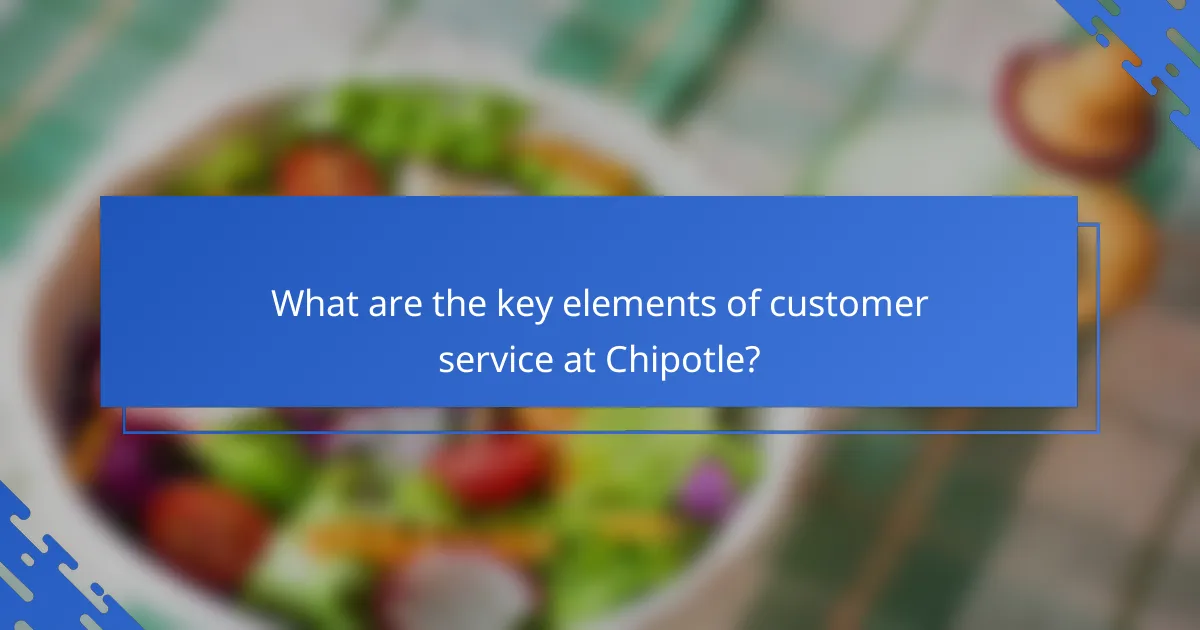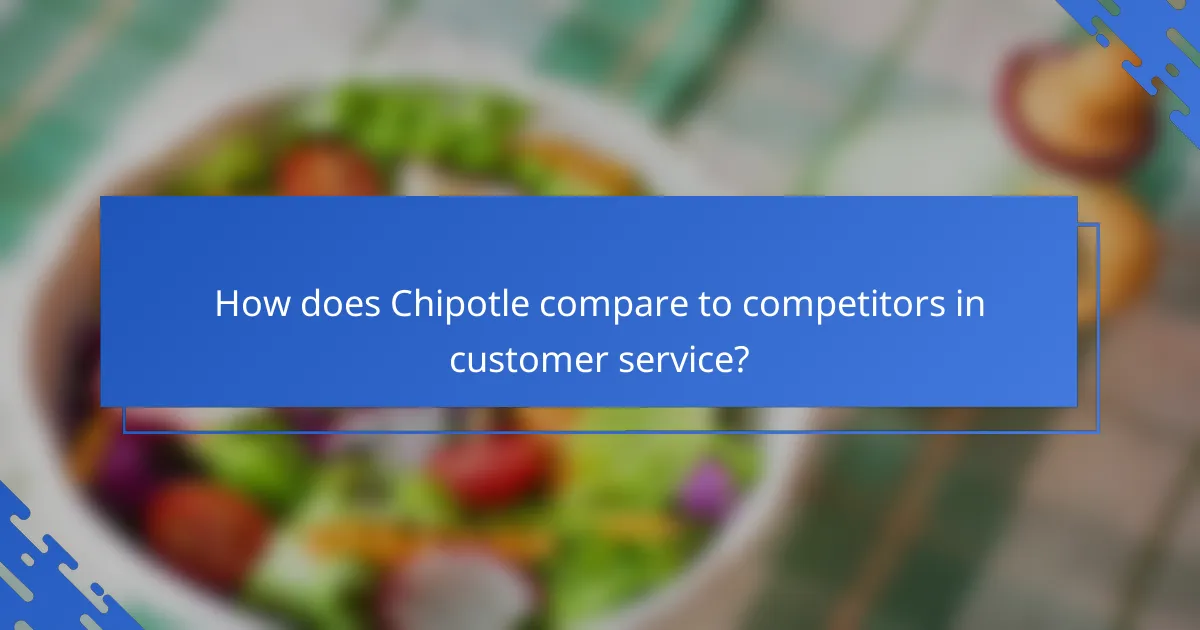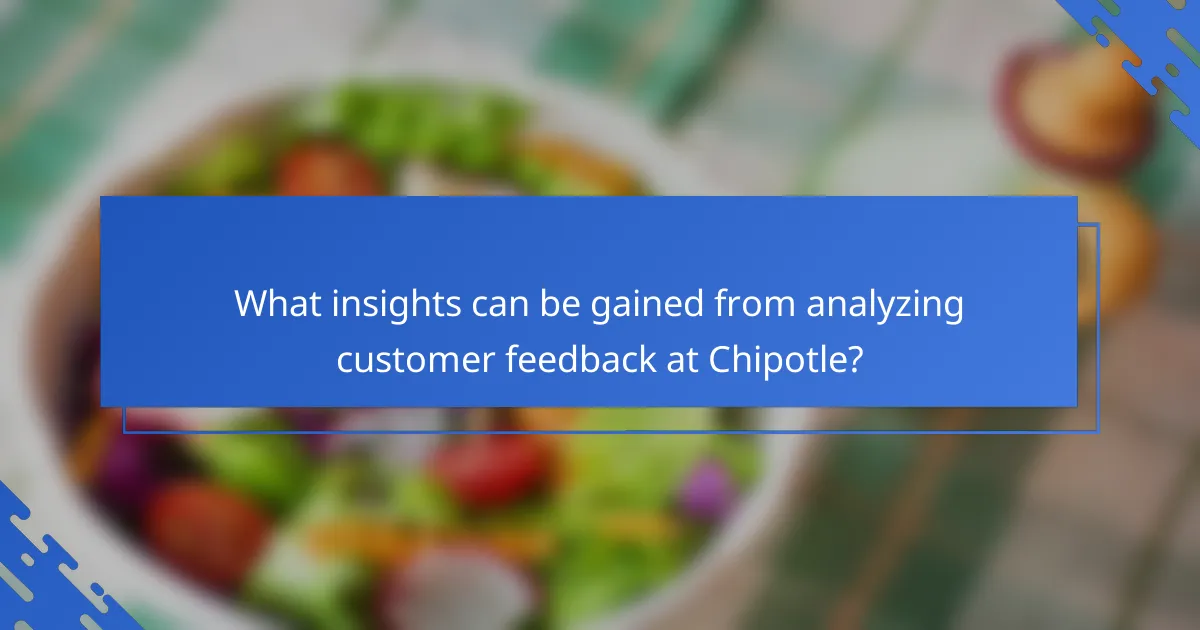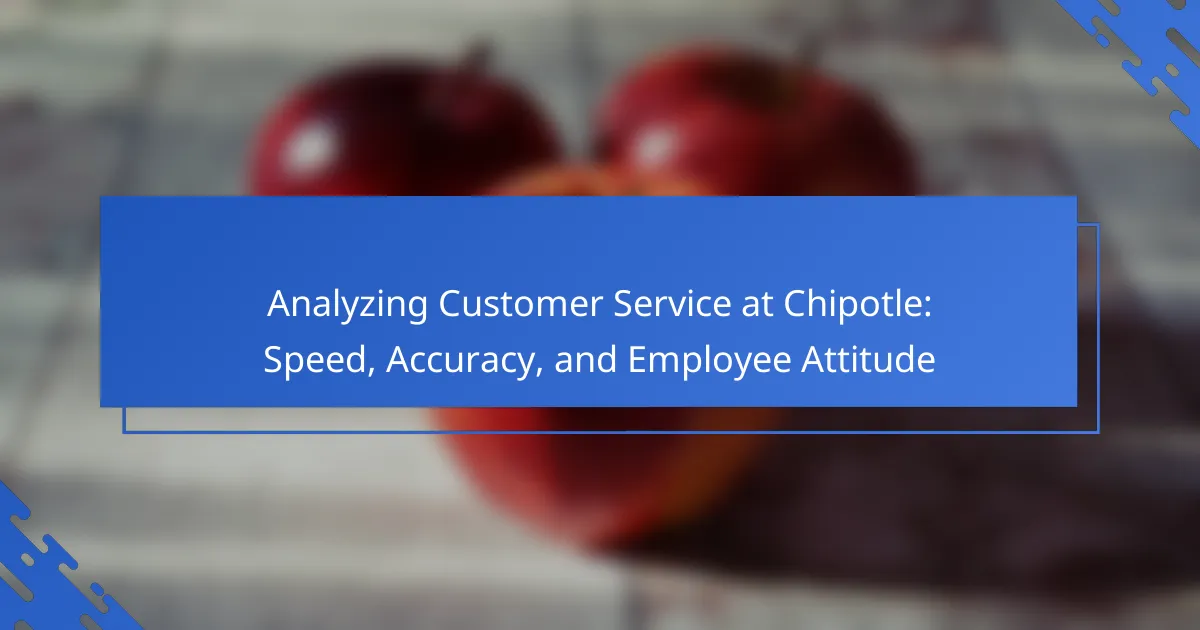The primary entity in this article is Chipotle, a fast-casual dining restaurant known for its customer service. Key elements of Chipotle’s customer service include speed, accuracy, and employee attitude, which are essential for meeting customer expectations. The article highlights how these elements contribute to Chipotle’s favorable ranking in customer satisfaction compared to competitors, supported by data from the American Customer Satisfaction Index. It also discusses the importance of customer feedback in identifying strengths and weaknesses in service quality, ultimately guiding improvements in the dining experience. Overall, the article provides an overview of how Chipotle maintains its reputation for excellent customer service through effective training and responsiveness to customer input.

What are the key elements of customer service at Chipotle?
The key elements of customer service at Chipotle include speed, accuracy, and employee attitude. Speed is critical as customers expect quick service during peak hours. Accuracy ensures that orders are prepared correctly, minimizing customer complaints. Employee attitude plays a vital role in creating a positive dining experience. Friendly and knowledgeable staff enhance customer satisfaction. Chipotle emphasizes training to maintain these standards. The company also gathers customer feedback to improve service continually. These elements collectively contribute to Chipotle’s reputation for excellent customer service.
How does speed impact customer satisfaction at Chipotle?
Speed significantly impacts customer satisfaction at Chipotle. Fast service leads to higher customer satisfaction ratings. Research indicates that customers value quick meal preparation and delivery. A study found that 70% of customers prefer faster service during peak hours. Additionally, speed enhances the overall dining experience. When customers receive their orders quickly, they are more likely to return. This trend is evident in Chipotle’s customer feedback and satisfaction surveys. Efficient service contributes to positive brand perception and loyalty.
What factors contribute to the speed of service in Chipotle restaurants?
The speed of service in Chipotle restaurants is influenced by several key factors. Efficient staff training ensures employees can quickly prepare and serve food. The assembly line setup allows for streamlined order processing. High-quality ingredients are prepped in advance, reducing wait times. Technology integration, such as mobile ordering, enhances order accuracy and speed. Customer flow management minimizes congestion during peak hours. Finally, a strong emphasis on teamwork among staff members contributes to faster service delivery.
How does wait time influence customer perceptions?
Wait time significantly influences customer perceptions by shaping their overall experience. Longer wait times can lead to frustration and dissatisfaction. Research indicates that customers often equate wait time with service quality. A study published in the Journal of Service Research found that perceived wait time impacts customer satisfaction levels. Customers expect prompt service, and delays can negatively affect their perception of the brand. Conversely, shorter wait times generally enhance customer satisfaction. This connection between wait time and perception is crucial for businesses like Chipotle, where efficiency is key to customer retention.
What role does accuracy play in Chipotle’s customer service?
Accuracy is crucial in Chipotle’s customer service as it directly impacts customer satisfaction. Accurate order fulfillment ensures that customers receive exactly what they requested. This reduces the likelihood of complaints and returns, fostering a positive dining experience. A study by the National Restaurant Association found that 70% of customers prioritize order accuracy when choosing a restaurant. Additionally, accurate service enhances operational efficiency, minimizing waste and operational costs. Chipotle’s commitment to accuracy reflects its brand values and contributes to customer loyalty.
How is order accuracy measured at Chipotle?
Order accuracy at Chipotle is measured by comparing the items prepared to the customer’s order. This process includes checking for correct ingredients and portion sizes. Employees use order tickets to ensure accuracy during preparation. Feedback from customers also contributes to measuring accuracy. Chipotle tracks order accuracy metrics to identify areas for improvement. Regular training sessions help maintain high standards. Data from customer surveys may reflect satisfaction levels regarding order accuracy. Overall, these methods ensure that Chipotle meets customer expectations effectively.
What are the consequences of inaccurate orders for customers and the business?
Inaccurate orders lead to dissatisfaction for customers and financial losses for businesses. Customers may receive incorrect items, which can result in frustration and a negative dining experience. This dissatisfaction often leads to complaints and negative reviews, impacting the business’s reputation. Additionally, businesses face increased operational costs due to the need for order corrections and potential refunds. Research indicates that 70% of customers are likely to switch to a competitor after a negative experience. This customer churn can significantly affect long-term profitability. Accurate orders are crucial for maintaining customer loyalty and ensuring operational efficiency.
How does employee attitude affect customer experiences at Chipotle?
Employee attitude significantly impacts customer experiences at Chipotle. Positive employee attitudes lead to better customer interactions and satisfaction. Happy employees are more likely to provide friendly service. This friendliness enhances the overall dining experience. Studies show that customer satisfaction is closely linked to employee engagement. For instance, a Gallup study indicates that engaged employees can increase customer ratings by up to 10%. In contrast, negative employee attitudes can result in poor service and customer dissatisfaction. This dissatisfaction can lead to lower repeat business and negative reviews. Therefore, fostering a positive employee attitude is crucial for enhancing customer experiences at Chipotle.
What training do Chipotle employees receive to enhance customer interactions?
Chipotle employees receive training focused on customer service skills to enhance interactions. This training includes modules on effective communication and active listening. Employees learn to engage customers positively and address their needs promptly. Role-playing scenarios are often used to practice real-life customer interactions. Additionally, employees are trained in menu knowledge to provide accurate information. This comprehensive approach aims to improve both speed and accuracy in service. Studies have shown that effective training contributes to higher customer satisfaction scores.
How can employee attitude influence repeat business?
Employee attitude significantly influences repeat business. Positive employee attitudes enhance customer experiences. Customers are more likely to return if they feel valued and appreciated. A study by the Harvard Business Review found that customer satisfaction increases by 20% when employees exhibit positive attitudes. Additionally, employees with a good attitude contribute to a welcoming environment. This environment encourages customer loyalty and repeat visits. Conversely, negative employee attitudes can lead to dissatisfaction. Unsatisfied customers are less likely to return, impacting overall sales. Thus, employee attitude directly correlates with customer retention and repeat business.
What strategies can Chipotle implement to improve customer service?
Chipotle can implement several strategies to improve customer service. First, enhancing employee training programs can ensure staff are knowledgeable and efficient. This training should focus on speed, accuracy, and customer interaction skills. Second, implementing a customer feedback system can help identify areas for improvement. Regularly analyzing feedback can guide necessary adjustments. Third, increasing staff during peak hours can reduce wait times. Studies show that shorter wait times improve customer satisfaction. Fourth, utilizing technology for order accuracy can minimize errors. Digital ordering systems can streamline the process and enhance the customer experience. Lastly, creating a rewards program can incentivize repeat business and improve customer loyalty. These strategies can collectively lead to a better customer service experience at Chipotle.

How does Chipotle compare to competitors in customer service?
Chipotle generally ranks favorably in customer service compared to its competitors. It is known for speed in service, often delivering orders faster than many fast-casual dining options. A 2022 survey by the American Customer Satisfaction Index showed Chipotle scored higher than the industry average in customer satisfaction. Customers frequently cite the accuracy of their orders as a strong point for Chipotle. Employee attitude also contributes positively, with many customers noting friendly and helpful staff. This combination of speed, accuracy, and employee engagement helps Chipotle stand out in the competitive landscape of fast-casual dining.
What benchmarks are used to evaluate customer service in the fast-casual industry?
Key benchmarks to evaluate customer service in the fast-casual industry include speed of service, order accuracy, and employee attitude. Speed of service is often measured by the time taken from order placement to food delivery. Studies indicate that fast-casual restaurants aim for an average service time of under 10 minutes. Order accuracy assesses how often customers receive their correct orders, with industry standards typically targeting an accuracy rate above 95%. Employee attitude is evaluated through customer feedback and mystery shopper reports, focusing on friendliness and helpfulness. These benchmarks help fast-casual restaurants like Chipotle maintain high customer satisfaction and loyalty.
How do Chipotle’s customer service metrics stack up against industry standards?
Chipotle’s customer service metrics generally meet or exceed industry standards. In 2022, Chipotle reported an average service speed of around 200 seconds per order. This is competitive compared to the fast-casual dining industry, which averages approximately 250 seconds. Additionally, Chipotle has a customer satisfaction score of 80%, higher than the industry average of 75%. Their accuracy in order fulfillment stands at 95%, which is above the typical standard of 90% in the sector. These metrics indicate that Chipotle performs well in speed, accuracy, and overall customer satisfaction compared to its peers.
What best practices can be learned from competitors?
Competitors’ best practices in customer service can inform improvements at Chipotle. Speed is critical; competitors like Chick-fil-A optimize service times through efficient staff training. Accuracy in order fulfillment is essential; businesses like McDonald’s use technology to minimize errors. Employee attitude influences customer experience; companies such as Starbucks invest in employee engagement programs. Regular training sessions enhance service quality; competitors often implement continuous improvement strategies. Monitoring customer feedback provides insights for adjustments; brands like Panera Bread actively solicit and act on customer opinions. By analyzing these practices, Chipotle can enhance its customer service approach effectively.
What unique challenges does Chipotle face in delivering customer service?
Chipotle faces unique challenges in delivering customer service due to high customer volume and customization demands. The fast-casual model requires quick service while maintaining food quality. This balance can lead to longer wait times during peak hours. Additionally, the need for accurate order customization increases the risk of errors. Employee training is crucial but can be inconsistent across locations. High turnover rates further complicate service consistency. Chipotle’s commitment to fresh ingredients can also slow down service speed, impacting customer satisfaction. These factors create a complex environment for effective customer service delivery.
How do operational challenges impact service delivery at Chipotle?
Operational challenges significantly hinder service delivery at Chipotle. These challenges can include supply chain disruptions, staffing shortages, and equipment failures. Supply chain disruptions lead to ingredient shortages, resulting in menu items being unavailable. Staffing shortages cause longer wait times as fewer employees are present to serve customers. Equipment failures can delay food preparation, impacting overall service speed. A study by the National Restaurant Association highlights that 57% of restaurants reported operational challenges affecting customer service. These factors collectively diminish customer satisfaction and experience at Chipotle.
What are the seasonal fluctuations in customer service demands?
Customer service demands experience seasonal fluctuations influenced by various factors. During peak seasons, such as summer and holidays, customer traffic increases significantly. This surge leads to higher demands for service efficiency and responsiveness. Conversely, during off-peak seasons, such as late winter, customer traffic typically decreases. This results in lower service demands and allows for more personalized interactions. Data from the National Restaurant Association indicates that restaurants can see up to a 20% increase in customer volume during holiday seasons. Understanding these patterns helps businesses like Chipotle optimize staffing and training to meet fluctuating demands effectively.

What insights can be gained from analyzing customer feedback at Chipotle?
Analyzing customer feedback at Chipotle reveals key insights into service quality and customer satisfaction. Feedback allows identification of strengths and weaknesses in speed, accuracy, and employee attitude. For instance, consistent comments about long wait times indicate areas needing improvement. Positive feedback on employee friendliness can highlight effective training practices. Additionally, specific suggestions from customers can guide menu adjustments. Tracking feedback trends over time can show the impact of changes made in response to customer input. Overall, customer feedback serves as a vital tool for enhancing the dining experience at Chipotle.
How does Chipotle collect and analyze customer feedback?
Chipotle collects customer feedback through multiple channels, including surveys, social media, and direct customer interactions. The company utilizes online surveys sent via email after purchases to gather insights on customer satisfaction. Additionally, Chipotle monitors social media platforms for customer comments and reviews. This real-time feedback helps the company understand customer preferences and concerns. Chipotle analyzes the collected data using analytics tools to identify trends and areas for improvement. By examining both quantitative survey results and qualitative social media feedback, Chipotle can enhance its service quality. The company regularly updates its strategies based on feedback analysis to meet customer expectations effectively.
What tools and methods are used for gathering customer opinions?
Surveys and feedback forms are primary tools for gathering customer opinions. These tools can be distributed online or in-store. Online surveys often use platforms like SurveyMonkey or Google Forms. In-store feedback forms allow immediate customer input. Social media platforms also serve as valuable methods for collecting opinions. Customers frequently share their experiences on platforms like Twitter and Facebook. Additionally, direct interviews or focus groups provide qualitative insights. These methods enable businesses to understand customer satisfaction levels. Research shows that 70% of customers prefer giving feedback through digital channels.
How does feedback shape service improvements at Chipotle?
Feedback directly influences service improvements at Chipotle by identifying areas needing enhancement. Customer feedback is collected through surveys and social media. This data highlights specific issues such as order accuracy and wait times. Chipotle analyzes this feedback regularly to understand customer preferences. The company uses insights to train employees and refine processes. For instance, feedback prompted changes in food preparation methods to reduce wait times. Additionally, Chipotle implements new technologies based on customer suggestions. These actions demonstrate a commitment to continuous improvement driven by consumer input.
What common themes emerge from customer reviews regarding service?
Common themes in customer reviews regarding service at Chipotle include speed, accuracy, and employee attitude. Customers frequently mention the quick service during peak hours. Many reviews highlight the accuracy of orders, noting that items are often prepared as requested. Additionally, employee attitude is a recurring theme, with several customers praising staff for being friendly and helpful. Negative comments occasionally reference slow service during busy times. Overall, these themes reflect customer expectations for efficient and accurate service, alongside positive interactions with staff.
What are the most frequently mentioned praises and complaints?
The most frequently mentioned praises for Chipotle’s customer service include speed of service and food quality. Customers often appreciate the quick preparation times during peak hours. Many also highlight the freshness and taste of the ingredients used in their meals. Complaints typically focus on order accuracy and employee attitude. Customers frequently report receiving incorrect orders or missing items. Additionally, some patrons express dissatisfaction with the demeanor of staff members during interactions. These insights are based on customer reviews and feedback collected from various platforms.
How can customer feedback be utilized to enhance employee training?
Customer feedback can be utilized to enhance employee training by identifying specific areas for improvement. Analyzing customer reviews helps pinpoint common issues employees face. For instance, feedback may reveal that employees struggle with order accuracy. Training programs can then focus on improving attention to detail in order processing. Additionally, customer comments about service speed can highlight the need for efficiency training. Incorporating role-playing scenarios based on real feedback can better prepare employees for actual customer interactions. This data-driven approach ensures training is relevant and targeted. Studies show that organizations using customer feedback for training see a 20% increase in employee performance.
What practical tips can Chipotle implement to elevate customer service?
Chipotle can elevate customer service by enhancing employee training programs. Comprehensive training ensures staff are knowledgeable about menu items and customer preferences. Implementing a feedback system allows employees to learn from customer experiences. Encouraging staff to engage with customers can create a welcoming atmosphere. Streamlining the ordering process reduces wait times, improving customer satisfaction. Utilizing technology for order accuracy can minimize errors in food preparation. Regularly assessing customer service metrics helps identify areas needing improvement. These strategies align with Chipotle’s commitment to quality and customer experience.
The main entity of this article is Chipotle, a fast-casual dining restaurant known for its customer service. The article analyzes key elements of Chipotle’s customer service, focusing on speed, accuracy, and employee attitude. It discusses how speed impacts customer satisfaction, the factors contributing to efficient service, and the importance of order accuracy in enhancing the dining experience. Additionally, the article highlights the role of employee attitude in customer interactions, strategies for improving service, and how Chipotle compares to competitors in the fast-casual industry. Insights from customer feedback are also examined to identify areas for service enhancement.
